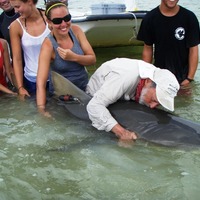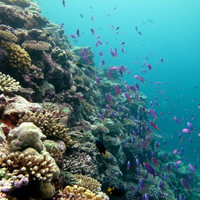
Renato Freitas
Related Authors
Ricardo de Souza Rosa
UFPB - Universidade Federal da Paraíba
Colin Simpfendorfer
James Cook University
Bryan Legare
University of the Virgin Islands
Conrad Speed
Australian Institute of Marine Science
Florencia Cerutti-Pereyra
Charles Darwin Foundation
Kevin Feldheim
Field Museum
Andy Danylchuk
University of Massachusetts Amherst
InterestsView All (12)








Uploads
Papers by Renato Freitas
Although estimates of survival, particularly for young age classes, are essential for assessing, monitoring and effectively
managing animal populations, there have been relatively few calculations of survival within shark populations and even fewer
estimates based on direct methods for sharks on their nursery grounds. We used tag-recapture methods to estimate the
population size and survival of juvenile lemon sharks (Negaprion brevirostris) on their nursery grounds at Atol das Rocas, a
marine protected area in Brazil. Sharks were sampled from1999 to 2003. Population size estimates ranged from 12 to 100 juvenile
sharks and survival estimates ranged between 24-54% with a mean of 44.6% over the most robust sampling periods. The
population of juvenile lemon sharks declined over the course of our study, whereas survival rates may have increased over the
same time period. Even a modest level of fishing and removal of mature females in adjacent areas may dramatically affect small
populations of sharks within a small and isolated nursery such as Atol das Rocas. The lower survival rates and population size
at Atol das Rocas could be the result of differences in physical characteristics of this nursery in comparison to others used by
lemon sharks in the northwestern Atlantic. Such comparatively lower populational parameters suggest that the population of
young lemon sharks is fragile at the Atol das Rocas nursery.
Although estimates of survival, particularly for young age classes, are essential for assessing, monitoring and effectively
managing animal populations, there have been relatively few calculations of survival within shark populations and even fewer
estimates based on direct methods for sharks on their nursery grounds. We used tag-recapture methods to estimate the
population size and survival of juvenile lemon sharks (Negaprion brevirostris) on their nursery grounds at Atol das Rocas, a
marine protected area in Brazil. Sharks were sampled from1999 to 2003. Population size estimates ranged from 12 to 100 juvenile
sharks and survival estimates ranged between 24-54% with a mean of 44.6% over the most robust sampling periods. The
population of juvenile lemon sharks declined over the course of our study, whereas survival rates may have increased over the
same time period. Even a modest level of fishing and removal of mature females in adjacent areas may dramatically affect small
populations of sharks within a small and isolated nursery such as Atol das Rocas. The lower survival rates and population size
at Atol das Rocas could be the result of differences in physical characteristics of this nursery in comparison to others used by
lemon sharks in the northwestern Atlantic. Such comparatively lower populational parameters suggest that the population of
young lemon sharks is fragile at the Atol das Rocas nursery.